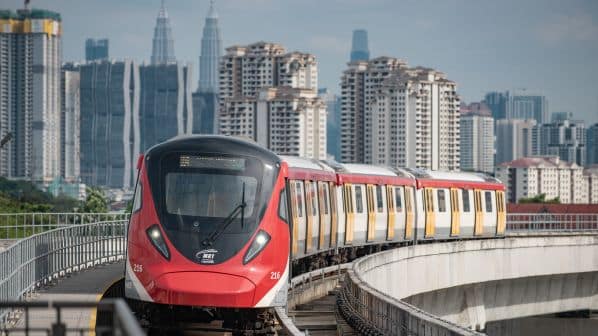THE MRT Putrajaya Line Phase 2 began operation at 15.00 on March 16 and is expected to play a big part in reducing traffic congestion, particularly on roads and expressways leading to Kuala Lumpur city centre, where large traffic jams have been a problem for commuters.
Phase 1 of Putrajaya Line, running between Kwasa Damansara and Kampung Batu stations, entered service as the city’s second heavy metro line on June 16 last year. The opening of Phase 2 brings into operation an additional 40.2km of line extending from Kampung Batu to Putrajaya Sentral station, as well as completing the full 57.7km length of the MRT Putrajaya Line, which has been built at a total cost of Ringgits 30.53bn ($US 6.78bn).
The line is fully automated at grade of automation four (GoA4), controlled from an operations centre in Sungai Buloh. Each train is equipped with two braking systems to ensure safety. Bombardier, now owned by Alstom, provided its Cityflo 650 CBTC solution as well as onboard equipment, while Global Rail was responsible for the platform screen doors, including the automatic platform gates and installation of the signalling equipment.
The line is served by 49 four-car trains, supplied by the HAP consortium of Hyundai Rotem, Apex Communications and Posco Engineering, which are branded with the name “Ducky.” Services operate from 06.00 to 00.00 every day, running at five-minute intervals during the peak, 10 minutes off-peak, and 15 minutes at weekends and during holidays. Each train has capacity to carry 1200 passengers.
The full Kwasa Damansara station to Putrajaya Sentral journey will now take 1h 24min, serving 36 stations including 10 interchanges that provide connections with the Kelana Jaya light rail line, Kajang MRT line and the KL monorail. Nine stations are underground.
MRT Rapid Rail chief operating officer, Mr Ramli Shafie says that the line’s Titiwangsa station serves an area being developed into a transport hub. “Touted to be the 'second KL Sentral,' commuters at the Titiwangsa station will be able to connect to LRT Ampang Line, LRT Sri Petaling Line and KL Monorail,” he explained during a press conference at Chan Sow Line station on March 14.
“The MRT feeder bus will provide the last mile connectivity to various destinations in the city,” he added.
The MRT Putrajaya Line also has park and ride facilities, with an additional 3445 parking spaces being provided as part of Phase 2, bringing the total number along the line to 6416 spaces at 17 stations.
For detailed data on metro projects in Asia and around the world, subscribe to IRJ Pro.

